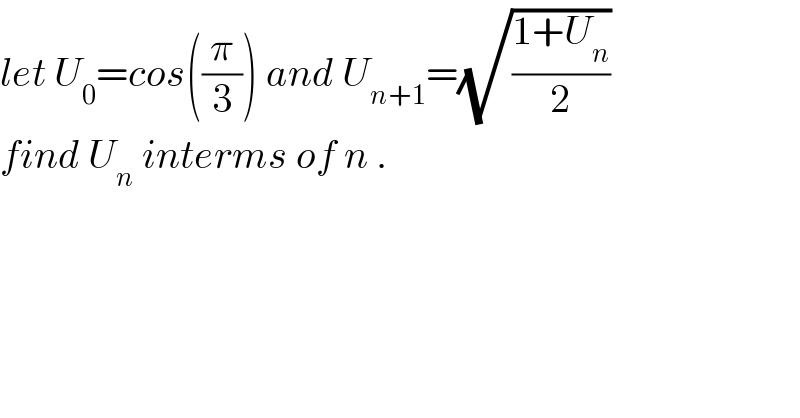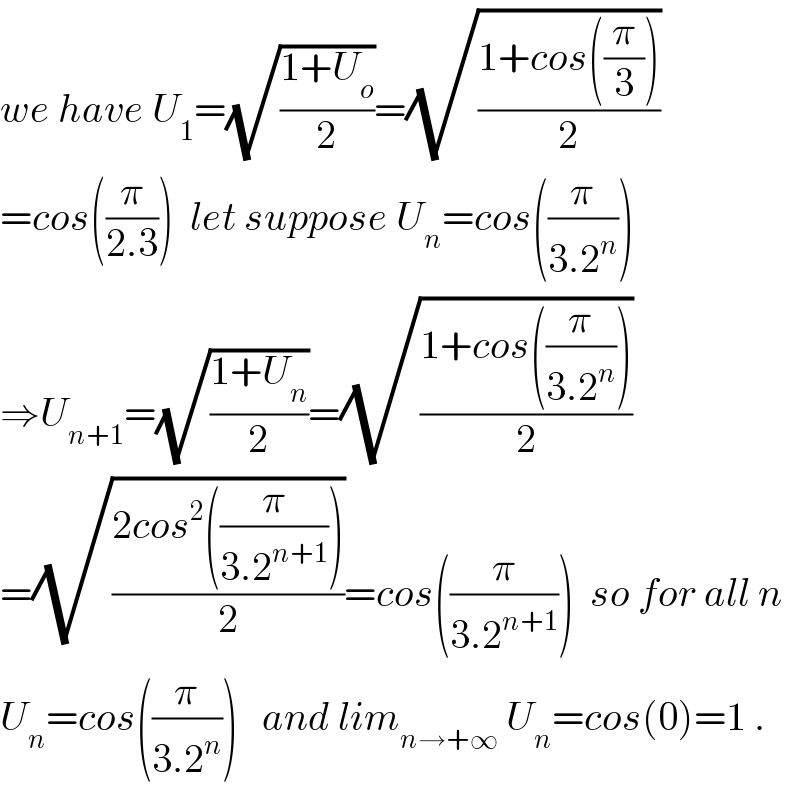
Previous in Relation and Functions Next in Relation and Functions
Question Number 57407 by Abdo msup. last updated on 03/Apr/19

$${let}\:{U}_{\mathrm{0}} ={cos}\left(\frac{\pi}{\mathrm{3}}\right)\:{and}\:{U}_{{n}+\mathrm{1}} =\sqrt{\frac{\mathrm{1}+{U}_{{n}} }{\mathrm{2}}} \\ $$$${find}\:{U}_{{n}} \:{interms}\:{of}\:{n}\:. \\ $$
Commented by Abdo msup. last updated on 05/Apr/19

$${we}\:{have}\:{U}_{\mathrm{1}} =\sqrt{\frac{\mathrm{1}+{U}_{{o}} }{\mathrm{2}}}=\sqrt{\frac{\mathrm{1}+{cos}\left(\frac{\pi}{\mathrm{3}}\right)}{\mathrm{2}}} \\ $$$$={cos}\left(\frac{\pi}{\mathrm{2}.\mathrm{3}}\right)\:\:{let}\:{suppose}\:{U}_{{n}} ={cos}\left(\frac{\pi}{\mathrm{3}.\mathrm{2}^{{n}} }\right) \\ $$$$\Rightarrow{U}_{{n}+\mathrm{1}} =\sqrt{\frac{\mathrm{1}+{U}_{{n}} }{\mathrm{2}}}=\sqrt{\frac{\mathrm{1}+{cos}\left(\frac{\pi}{\mathrm{3}.\mathrm{2}^{{n}} }\right)}{\mathrm{2}}} \\ $$$$=\sqrt{\frac{\mathrm{2}{cos}^{\mathrm{2}} \left(\frac{\pi}{\mathrm{3}.\mathrm{2}^{{n}+\mathrm{1}} }\right)}{\mathrm{2}}}={cos}\left(\frac{\pi}{\mathrm{3}.\mathrm{2}^{{n}+\mathrm{1}} }\right)\:\:{so}\:{for}\:{all}\:{n} \\ $$$${U}_{{n}} ={cos}\left(\frac{\pi}{\mathrm{3}.\mathrm{2}^{{n}} }\right)\:\:\:{and}\:{lim}_{{n}\rightarrow+\infty} \:{U}_{{n}} ={cos}\left(\mathrm{0}\right)=\mathrm{1}\:. \\ $$
